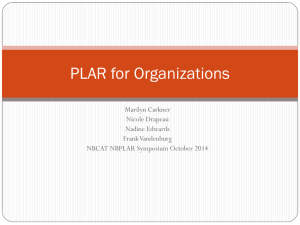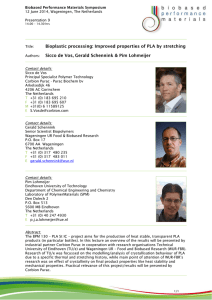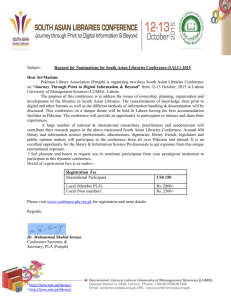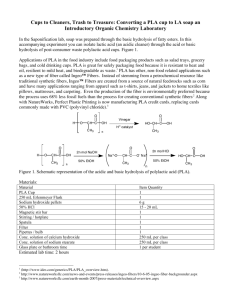WORD
advertisement
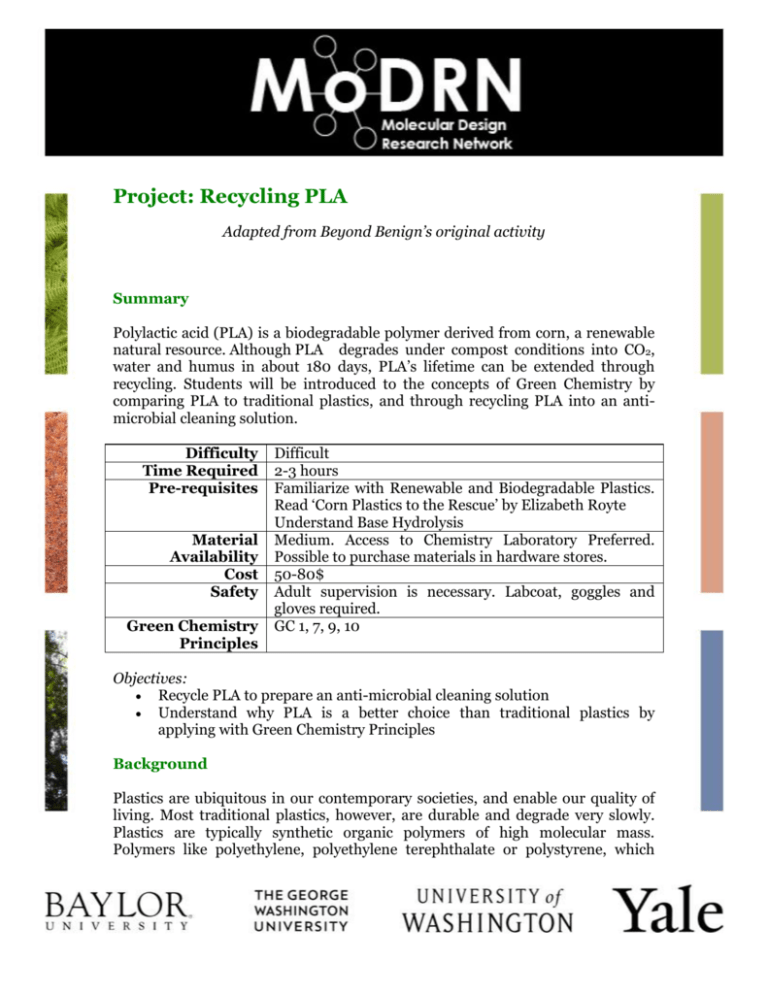
Project: Recycling PLA Adapted from Beyond Benign’s original activity Summary Polylactic acid (PLA) is a biodegradable polymer derived from corn, a renewable natural resource. Although PLA degrades under compost conditions into CO2, water and humus in about 180 days, PLA’s lifetime can be extended through recycling. Students will be introduced to the concepts of Green Chemistry by comparing PLA to traditional plastics, and through recycling PLA into an antimicrobial cleaning solution. Difficulty Time Required Pre-requisites Material Availability Cost Safety Green Chemistry Principles Difficult 2-3 hours Familiarize with Renewable and Biodegradable Plastics. Read ‘Corn Plastics to the Rescue’ by Elizabeth Royte Understand Base Hydrolysis Medium. Access to Chemistry Laboratory Preferred. Possible to purchase materials in hardware stores. 50-80$ Adult supervision is necessary. Labcoat, goggles and gloves required. GC 1, 7, 9, 10 Objectives: Recycle PLA to prepare an anti-microbial cleaning solution Understand why PLA is a better choice than traditional plastics by applying with Green Chemistry Principles Background Plastics are ubiquitous in our contemporary societies, and enable our quality of living. Most traditional plastics, however, are durable and degrade very slowly. Plastics are typically synthetic organic polymers of high molecular mass. Polymers like polyethylene, polyethylene terephthalate or polystyrene, which constitute plastics, can persist for 500 to 1000 years in our environment. Despite their very long degradation times, plastics tend to be used for very short periods and discarded, thus persisting in landfills. In addition, traditional plastics are derived from petroleum sources. Polylactic acid (PLA) is a polymer synthesized from polymerization of lactic acid, a monomer derived from corn, a renewable resource. PLA’s structure allows current composting enzymes and bacteria to break it down within 180 days, forming carbon dioxide, water and humus. To grow, corn necessitates carbon dioxide intake for photosynthesis. The released carbon dioxide during PLA degradation can be considered to re-enter the carbon cycle during corn growth. Thus, PLA degradation results in no net carbon dioxide emissions into the Earth’s atmosphere. Because PLA degrades so readily, there are currently no facilities to recycle it. One method to extend PLA’s lifetime, however, is to recycle the plastic. In this experiment, PLA will be converted to an anti-microbial cleaning solution by base hydrolysis of the plastic. Key Terms & Concepts: Polylactic Acid (PLA), Lactic Acid, Base, Acid, Hydrolysis, Renewable Resource, Biodegradation, Polymers. Materials: 9 oz. PLA cup Hot Plate Stir Bar (can be substituted by manual stirring with a glass rod) Thermometer (up to 150oC) 3 x 250 mL Erlenmeyer flasks 100 mL graduated cylinder (measuring cup) Muriatic Acid (aqueous HCl 36%) Caustic Soda Beads (NaOH) Blue Litmus Paper Weighing Paper/Boat pH Strips Distilled water Ethanol Plastic pipette heat resistant gloves or tongs Procedure: 1. 2. Put on Lab Coat, goggles, and latex or nitrile gloves. Prepare 1.4 M NaOH in 1:1 H2O:Ethanol: Weigh 5.6 g of NaOH on a scale and transfer into the Erlenmeyer Flask Add 50 mL of distilled water to the Erlenmeyer. Stir the solution until all of the beads are dissolved. Add slowly 50 mL of Ethanol to the Erlenmeyer flask. Mix thoroughly by stirring. Label solution “1.4 M NaOH in 1:1 H2O:Ethanol” and set aside. Prepare 10 mL 6M HCl solution: Add 5 mL distilled water and a magnetic stir bar to an Erlenmeyer flask. Very slowly, add 5 mL muriatic acid (36% HCl) to the Erlenmeyer flask and allow to mix thoroughly. Label Erlenmeyer ‘6M HCl in H2O’ and set aside. Cut the PLA cup into small pieces. Do not use any of the green parts. Measure 5g of PLA piece and add to a 250 mL Erlenmeyer flask. Add 100 mL of 1.4 M NaOH solution and a stir bar into the Erlenmeyer flask. Place onto the hot plate. Heat the solution to 90oC with stirring (reduce the heat if vigorous boiling is observed). Heat the solution until all the PLA pieces have dissolved. Upon completion, the solution should be pale yellow. Turn off the hot plate. Remove the Erlenmeyer flask from the hot plate using heat resistant gloves. Allow the solution to cool until it is at about 60 oC (you may place the flask in an ice-water bath). Test and record the pH of the solution. The solution now contains hydrolyzed PLA. Slowly add 50 drops of 6M HCl solution to the Erlenmeyer and mix thoroughly. Test the pH of the solution with blue litmus paper and record whether it is basic or acidic. Repeat steps 9-10 until the solution is acidic. Measure the final pH of the solution using pH strips, and slowly add drops of 6 M HCl solution until a pH of 4-5 is obtained. The solution now contains lactic acid and sodium chloride (NaCl – salt!). It is an effective anti-microbial cleaning solution. You may use it to clean dirty surfaces. Observations 1. Why is it important to cut the PLA cup into small pieces before proceeding with Hydrolysis? 2. Why do we avoid using any of the green parts of the PLA cup? 3. Name the green chemistry principles that this experiment relates to and explain why.

